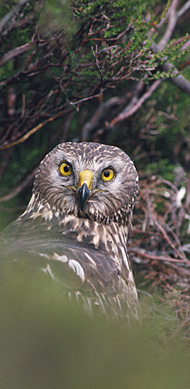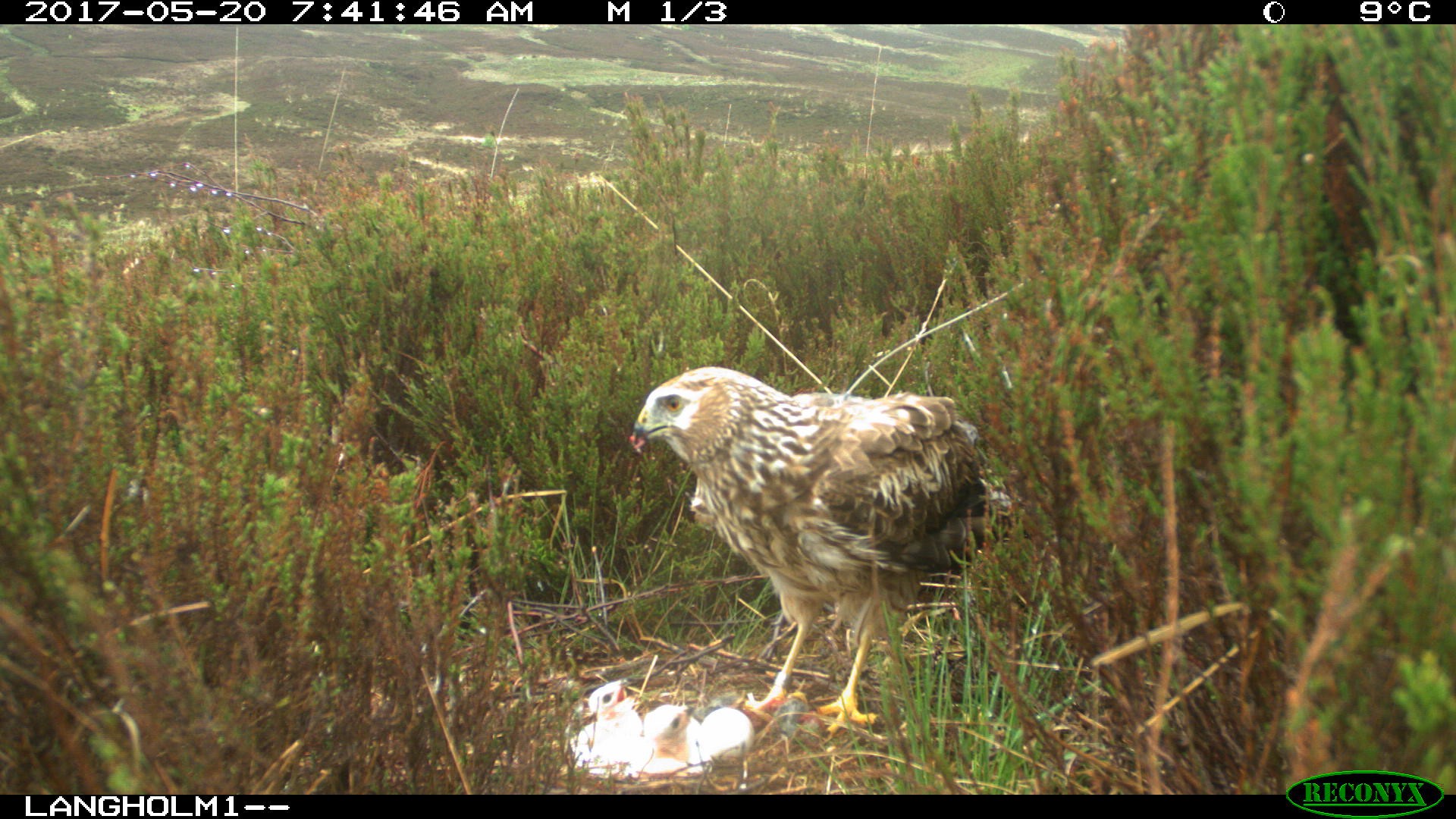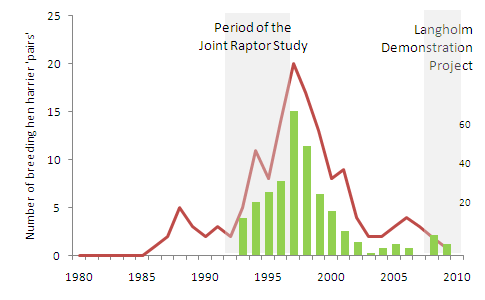
| HOME |
| PROJECT DETAILS |
| PROJECT ADMINSTRATION |
| PUBLICATIONS |
| JOINT RAPTOR STUDY |
| THE MOOR |
| THE GROUSE |
| OTHER WILDLIFE |
| DIVERSIONARY FEEDING |
| GAMEKEEPING |
| WILDLIFE SURVEYS |
| NEWS |
| CONTACT |
| PHOTO GALLERY |
| Date | Download documents |
| September 2014 | 2014 Raptor Monitoring Report |
THE RAPTORS |
||||||||||||||||||||||||||||||
|
Hen Harriers Marked hen harriers at Langholm: An update In 2018 Heads Up for Harriers cameras were placed at nests at Langholm. They recorded some interesting images, including what is probably the first ever confirmed predation of a harrier nest by a short-eared owl and an attentive male harrier at a nest.
Marked hen harriers at Langholm: An update Since the Langholm Moor Demonstration Project began, Natural England marked 18 hen harrier chicks with satellite tags in order to better understand their dispersal and survival. Marked hen harriers are also contributing to the conservation efforts of other associated projects, such as the RSPB Hen Harrier Life+ Project, and the PAWS “Heads up for Harriers” project. During the summer of 2017, five satellite-tagged hen harriers have been recorded on Langholm Moor, and this post is intended as an update. Two female hen harriers, Hattie and Grainne, hatched and tagged in 2013 at Langholm Moor, have not left our area for any length of time, and both have nested with us from 2014-17. A further female bird, Sorrell, which was tagged and fledged from Langholm in 2016, then overwintered in south-west Scotland, and then made a long-distance movement to south Inverness-shire in May. Sorrell has now returned to Langholm but is non-breeding. Very recently, and “hot off the press”, a male hen harrier called “John”, which was tagged in Northumberland in 2016, has joined us. Field staff have also noted a colour-ringed male at Langholm Moor, which was ringed and fledged with us in 2014. The identification of another female hen harrier, which is nesting at Langholm in 2017 has been shrouded in mystery. A nest camera put in place as part of the “Heads up for Harriers” project revealed that this bird is both carrying a satellite tag and a BTO metal ring. Following extensive checks with all researchers involved with satellite-tagging hen harriers in the UK and elsewhere in Europe, we have determined that the satellite tag is not functioning.
However, in the past fortnight we finally managed to take some photographs, which has allowed us to read parts of the leg ring. This has revealed that the bird is most likely Miranda, a four-year-old female hatched and tagged at Langholm in 2013, last recorded in July 2014 in Northern Ireland. As she is breeding this season, and we do not want to run the risk of causing nest desertion, no attempts have been made to trap Miranda and remove the satellite tag. If we get a suitable opportunity later in the year, trapping of Miranda, using authorised techniques undertaken by skilled practitioners, will be actively considered. Duncan Orr-Ewing Hen harriers were first recorded at Langholm in the 1980s and for several years there were between 2 and 5 pairs. The hen harrier is the qualifying feature of the Newcastleton Hills SPA and the site is of international importance for this species. Other large predatory birds which regularly breed at Langholm include the peregine and the raven. Numbers of hen harriers rose rapidly during the Joint Raptor Study but declined back to earlier levels afterwards. Some changes in harrier numbers and breeding success are caused by changes in vole and meadow pipit numbers which are their principal prey and which influence where they settle on the moor in spring.
Numbers of hen harrier 'pairs' breeding at Langholm (red line). In some cases male harriers paired with more than one female, so here each female is counted as a pair. Green bar chart shows number of harrier chicks fledged at Langholm since 1992 (right axis). During the project the number of hen harriers breeding is being recorded by watching for displaying males from a series of vantage points. Harrier chicks are counted and ringed. In 2008 there were two successful pairs which raised 9 chick between them. Food is provided to all known territories from late-March until the incubation period begins and then continued when the hen harrier chicks hatch, in an attempt to divert hen harriers away from predating on red grouse chicks. This method, which was trialed in 1998 and 1999, reduced by up to 86% in the numbers of red grouse chicks fed to hen harrier brood. It did not, however, lead to an increase in grouse stocks. Dispersal and Tagging The dispersal patterns of harriers in Scotland is generally not well understood, despite this having a probable influence on their survival and predation on prey during the winter. Since 2010 a proportion of the harrier chicks fledged at Langholm have been fitted with satellite tags which monitor their progress during the next year. The project has supported this because the more is known about the dispersal and fate of harriers the better to inform national conservation frameworks. We are particularly interested in the proportion of harriers that disperse and/or die naturally away from grouse moors as this is currently not known. Some of the dispersal movements have been remarkable. One male chick, (now known as 'McPedro') overwintered as far away as the north coast of Spain in 2010-11, returning to SW Scotland in May 2011. Click here to see the path taken by this wanderer. This male bird and two satellite tagged chicks from the two 2011 nests at Langholm have been followed through 2011. Signals from all three birds have now ceased, one in the Scottish Borders and two in northern France. As no remains or tags have been retrieved it is not possible to establish the fate of the harriers. Click here to see the final positions in France of the harriers tagged at Langholm. Natural England have led on this part of the project and their public relations team can be contacted here. Harrier Breeding in 2014 Hen harriers have had an incredible breeding season at Langholm with a total number of 12 nests (12 females, 6 monogamous and 3 bigamous males). Ten of these nests were successful and fledged 47 young (brood sizes between three and six), which is more than in all previous breeding seasons since the start of the project combined, the other two nests were deserted during incubation (one secondary female and a very late nesting attempt). The nests were discovered throughout the spring and summer, the last nest being identified in the third week of June. All the nests were diversionary fed during the period when young harriers were in the nest. This work was undertaken by the keepering team in the course of their normal duties; a careful record has been kept of the time and cost implications for further assessment. The science team undertook feeding when extra hands were needed. Two of the harrier chicks (one female from 'Grainne''s nest, and an additional male) were
fitted with
satellite tags by Stephen Murphy in mid-June as part of a separate Natural England project. Their fate can be followed as usual on the Making
the Most
of Moorlands Blog (http://langholmmoorland.blogspot.co.uk).
Where the untagged majority of these breeding harriers have come from is an active discussion as the change from 2 nests to 12 is unprecedented; it took a number of years to see the same rise during the Joint Raptor Study. It likely reflects reasonable breeding in SW Scotland in 2013, good overwintering conditions (plenty of prey and clement weather), and the social aspect of hen harriers which typically seek a semi-colonial nesting distribution. Common Buzzards There are sometimes noticeable numbers of buzzards hunting the moor at Langholm and the number of pairs breeding in the area has increased since the Joint Raptor Study. The Project wishes to understand whether this predator is having an effect on the survival of moorand birds and has commissioned work in 2011. Ravens In 2013 LMDP researchers fitted
young ravens with radio tags – the first time this has been done
within the UK.
As there is anecdotal evidence that raven prey both on grouse eggs and
chicks,
the project hoped the tags would provide information about movements of
the
raven family groups and the location of night roosts - for the
collection of
pellets. The raven tagging project supported the broader monitoring of grouse nests and broods, including nest cameras, temperature loggers and wax eggs to identify when and what is predating the grouse. However grouse nesting success was above average in 2013 with only two failed clutches (out of 20 monitored nests) so there was no conclusive evidence about the main causes for grouse nesting failure.
|
 |


